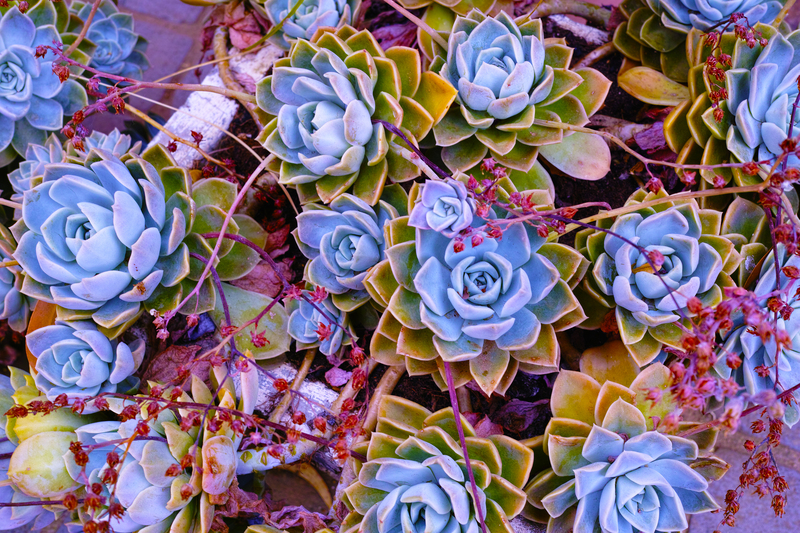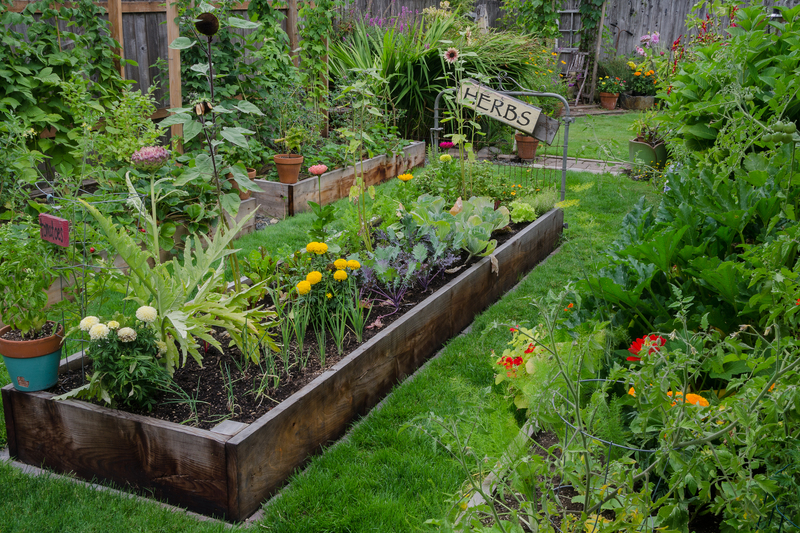Reaching New Heights with Vertical Gardening Designs
Posted on 12/09/2025
Reaching New Heights with Vertical Gardening Designs
Vertical gardening designs are changing the face of urban and small-space gardening. With rapid urbanization, limited ground space, and a growing appreciation for greener environments, vertical gardens are not just a trend--they are a sustainable solution for homes, offices, and urban landscapes worldwide. Whether you have a tiny balcony, a bare wall, or simply want to maximize your gardening potential, vertical gardening can help you achieve stunning results while also boosting biodiversity and air quality.

What is Vertical Gardening?
Vertical gardening is the creative practice of cultivating plants upwards, utilizing structures such as trellises, walls, containers, and modern hydroponic systems. This method enables anyone--regardless of the size of their available space--to introduce green life into their environment.
- Indoor Vertical Gardens: Often used as living walls or green partitions in offices and homes.
- Outdoor Vertical Gardens: Feature on patios, balconies, building exteriors, and community parks.
Vertical gardening designs act as a perfect fusion of form and function, merging aesthetic enhancement with practical plant cultivation.
Benefits of Vertical Gardening Designs
Embracing vertical gardens comes with a suite of advantages, some of which extend well beyond the realm of traditional gardening.
Optimizes Space Utilization
*Maximize your gardening area by growing upward rather than outward.* This is a game-changer for those limited by ground space, such as apartment dwellers or homeowners with small yards.
Improves Air Quality
*Vertical gardens filter airborne toxins, increase humidity, and produce oxygen, creating healthier atmospheres--especially invaluable in urban areas.*
Enhances Aesthetics
*Vertical gardening offers eye-catching design potential, transforming drab walls into lush, living tapestries and introducing vibrant color wherever you want.*
Increases Privacy and Shade
*Strategic placement of vertical gardens can offer privacy screens, block unsightly views, and provide welcome shade to sun-drenched windows and patios.*
Reduces Urban Heat Island Effect
*Covering building exteriors with greenery helps reduce ambient temperatures, benefiting city residents and the environment alike.*
Supports Biodiversity
*Vertical garden structures offer habitat and food for pollinators, birds, and beneficial insects--even in the heart of a city.*
Types of Vertical Garden Designs
Vertical gardening is highly adaptable, allowing for countless creative variations. Below are some popular and effective vertical garden designs:
1. Living Walls / Green Walls
- Description: Large panels or structures mounted on indoor or outdoor walls, planted with a variety of species.
- Features: Includes soil-based or hydroponic systems and often incorporates built-in watering mechanisms.
- Ideal for: Offices, commercial plazas, cafes, home feature walls.
2. Trellis and Climbing Gardens
- Description: Using trellises, arbors, or wires to support climbing plants like ivy, roses, beans, or peas.
- Features: Offers seasonal variation and classic green wall aesthetics.
- Ideal for: Garden fences, patios, outdoor facades.
3. Pocket and Planter Gardens
- Description: Wall-mounted fabric pockets or modular containers fitted with individual plants.
- Features: Highly customizable, easy to manage and rearrange.
- Ideal for: Herb gardens in kitchens, balconies, or even children's rooms.
4. Pallet and Recycled Gardens
- Description: Repurposed wooden pallets, gutters, or bottles used as budget-friendly vertical planters.
- Features: Sustainability meets creativity--an upcycled option for eco-conscious gardeners.
- Ideal for: DIY enthusiasts, educational projects, renters.
5. Hydroponic Vertical Systems
- Description: Soilless gardens where plant roots are supplied with nutrient-rich water, often via stackable towers.
- Features: Enables rapid, high-yield production with minimal mess.
- Ideal for: Modern interiors, commercial food production, and high-tech horticultural spaces.
Design Principles for Successful Vertical Gardens
If you want to create resilient and beautiful vertical gardening designs, consider these essential principles:
1. Assess the Environment
- Sunlight: Analyze direct/indirect light available--the key to plant selection and placement.
- Wind Exposure: Windy locations may dry out containers quickly--opt for hardier species or windbreaks.
2. Choose the Right Plants
- Light Requirements: Select sun-loving, shade-tolerant, or partial-shade plants accordingly.
- Water Needs: Group plants by similar watering requirements for easier maintenance.
- Growth Habit: Trailing, climbing, or compact plants work well in vertical layouts.
3. Use Suitable Structures
- Materials: Use rot-resistant wood, coated metal, durable plastics, or fabric for longevity.
- Weight Management: Ensure the wall or frame supports the combined weight of soil, water, and growing plants.
4. Ensure Proper Irrigation & Drainage
- Watering: Install drip irrigation, soaker hoses, or water-retentive fabrics.
- Drainage: Prevent waterlogging by including drainage holes or channels.
5. Focus on Maintenance
- Accessibility: Design for easy access to prune, harvest, and replace plants.
- Monitor Health: Regularly check for pests, diseases, and nutrient deficiencies.
Best Plants for Vertical Gardening
The choice of plants can make or break your vertical garden, so select species that thrive in your specific conditions. Here are some top options for various settings:
Leafy Greens & Edibles
- Lettuce and mixed salad greens
- Spinach
- Kale
- Strawberries
- Herbs: Basil, Mint, Thyme, Parsley, Chives
- Cherry Tomatoes (dwarf or trailing varieties)
Flowering Plants
- Petunias
- Pansies
- Lobelias
- Impatiens (for shaded areas)
- Begonias
Foliage & Indoor Plants
- Pothos
- Philodendrons
- Spider plants
- Ferns (e.g. Boston, Maidenhair)
- Succulents
Climbers & Vines
- English Ivy
- Jasmine
- Climbing Roses
- Morning Glory
- Sweet Peas
Creative Vertical Gardening Ideas
Inject your personality into your garden wall with these innovative vertical gardening design ideas:
Pallet Wall Planter
*Reclaim a wooden pallet, add landscape fabric backing and fill with soil and your favorite succulents or herbs for rustic charm.*
Herb Ladder
*Lean a vintage ladder against your kitchen wall and secure small pots of fragrant herbs to each rung--a practical and aromatic display!*
Recycled Bottle Garden
*Turn plastic bottles into tiered planters, perfect for teaching kids about sustainability and creative reuse.*
Modern Modular Living Wall
*Install modular panel systems (such as felt or pocket panels) for a sleek, professional statement piece in living rooms or patios.*
Vertical Vegetable Planter
*Stacked wooden boxes or shelf units with trailing tomatoes, strawberries, and salad greens turn any patio into a productive kitchen garden.*
Maintaining Your Vertical Garden
- Regular Watering: Vertical gardens may dry out faster--consider automatic irrigation or check soil moisture often.
- Feed Wisely: Use slow-release fertilizers or liquid feeds suited for the plant selection and medium.
- Pruning & Grooming: Trim dead foliage, spent flowers, and encourage bushier growth as needed.
- Pest Monitoring: Keep an eye out for aphids, mites, and mealybugs, especially indoors.
- Seasonal Rotation: Refresh or rotate plants seasonally to keep your design vibrant year-round.
Common Challenges & How to Overcome Them
While vertical gardening offers many rewards, some challenges require attention:
- Water Runoff: Excess water can pool at the bottom--use trays and monitor for leaks.
- Uneven Light Distribution: Rotate plants, add supplemental lighting, or choose shade tolerant species for dim areas.
- Weight Load: Reinforce supports, especially with large living wall installations.
- Plant Health: Vigilance against disease and pests is key--inspect closely and act early at signs of trouble.
Sustainability and Eco-Friendly Practices
Modern vertical gardening designs are a sustainable answer to many pressing urban challenges:
- Water Conservation: Smart irrigation systems reduce waste; hydroponics can use less water than soil-based systems.
- Recycling: Use reclaimed materials for planters and supports to reduce environmental impact.
- Local Food Production: Growing edibles vertically cuts food miles and supports self-sufficiency.
- Biodiversity: Urban green walls provide habitats for pollinators and city wildlife.
*Incorporate compost, native plants, and drought-resistant varieties for a truly eco-friendly vertical oasis.*
Vertical Gardening Inspiration Around the World
Looking for inspiration? Explore these striking examples of vertical garden designs:
- Musee du Quai Branly, Paris: Patrick Blanc's lush living wall spans the museum's exterior, home to hundreds of plant species.
- One Central Park, Sydney: A multi-story mixed-use development boasting over 1,200 square meters of planted facades.
- Edible Walls in Singapore: HDB flats showcase vertical vegetable gardens, supporting the city-state's food security initiatives.
- Private Residences Worldwide: From Swedish apartments to Californian bungalows, homeowners are creating green havens on balconies, patios, and even bedrooms.
Getting Started with Your Own Vertical Garden
Are you ready to transform your space with vertical gardening? Here's a quick roadmap:
- Evaluate Your Space: Measure dimensions, check sunlight and wind exposure, and note structures available for support.
- Set Your Goals: Do you want an ornamental wall, a productive edible patch, or an environmental buffer?
- Design Your System: Sketch or plan your layout, choose your structural support and planter type.
- Select Plants Carefully: Mix colors, textures, and species for visual interest and resilience.
- Install & Plant: Secure your framework, fill with planting medium, arrange plants thoughtfully, and water in.
- Maintain Consistently: Schedule watering, feeding, pruning, and regular checks for top results.

Conclusion: Reaching New Heights with Vertical Gardens
Vertical gardening designs offer a creative, sustainable, and visually captivating way to green any environment--from studio apartments to commercial buildings and public spaces. By utilizing both cutting-edge and DIY approaches, gardeners everywhere can reach new heights (literally!) in cultivating lush, vibrant, and functional living walls. As you design, plant, and enjoy your own vertical garden, you're not just creating a beautiful feature--you're contributing to a healthier, more sustainable world.
Embrace the future of gardening today--let your imagination (and your plants) soar vertically!
Frequently Asked Questions
- Can I create a vertical garden indoors?
Absolutely! Many plants thrive indoors with enough light and air circulation. Opt for species like ferns, pothos, or even salad greens, and use wall planters, pocket organizers, or modular panels. - Do vertical gardens require a lot of maintenance?
Maintenance depends on your setup--automatic irrigation and smart plant choices make the process easier. Regular checks are essential for healthy growth and system longevity. - How much does a vertical gardening system cost?
Costs vary--from affordable DIY pallet projects to high-end, automated green wall installations. Choose a solution that fits your budget and goals. - Is vertical gardening eco-friendly?
When designed responsibly, vertical gardens conserve water, enhance air quality, support biodiversity, and can even help insulate buildings--making them a great green investment.

